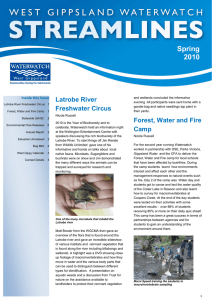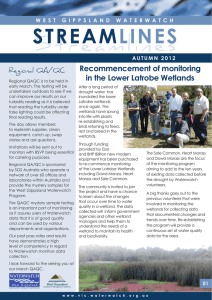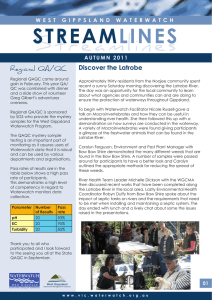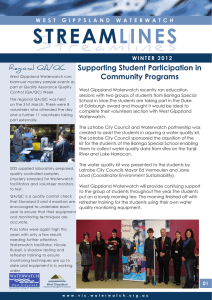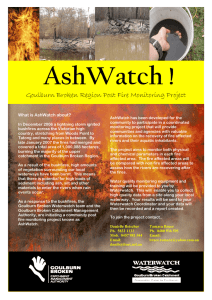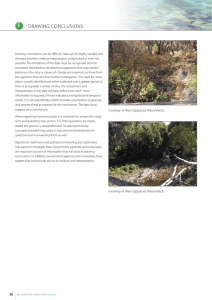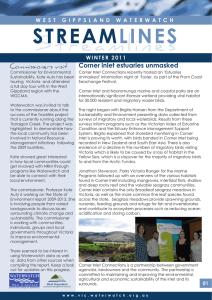Forest, Water & Fire School Camp Inside this Issue
advertisement
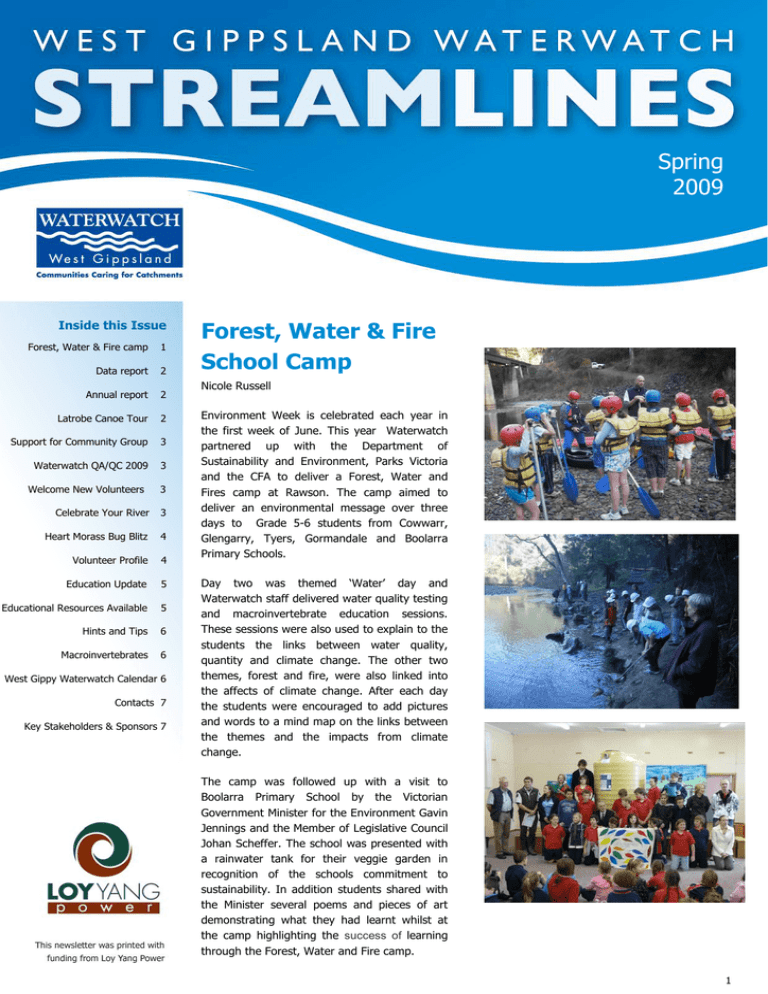
Spring 2009 Inside this Issue Forest, Water & Fire camp 1 Data report 2 Annual report 2 Latrobe Canoe Tour 2 Support for Community Group 3 Waterwatch QA/QC 2009 3 Forest, Water & Fire School Camp Nicole Russell Welcome New Volunteers 3 Celebrate Your River 3 Heart Morass Bug Blitz 4 Volunteer Profile 4 Education Update 5 Educational Resources Available 5 Hints and Tips 6 Macroinvertebrates 6 West Gippy Waterwatch Calendar 6 Contacts 7 Key Stakeholders & Sponsors 7 Environment Week is celebrated each year in the first week of June. This year Waterwatch partnered up with the Department of Sustainability and Environment, Parks Victoria and the CFA to deliver a Forest, Water and Fires camp at Rawson. The camp aimed to deliver an environmental message over three days to Grade 5-6 students from Cowwarr, Glengarry, Tyers, Gormandale and Boolarra Primary Schools. Day two was themed ‘Water’ day and Waterwatch staff delivered water quality testing and macroinvertebrate education sessions. These sessions were also used to explain to the students the links between water quality, quantity and climate change. The other two themes, forest and fire, were also linked into the affects of climate change. After each day the students were encouraged to add pictures and words to a mind map on the links between the themes and the impacts from climate change. The camp was followed up with a visit to Boolarra Primary School by the Victorian Government Minister for the Environment Gavin Jennings and the Member of Legislative Council Johan Scheffer. The school was presented with a rainwater tank for their veggie garden in recognition of the schools commitment to sustainability. In addition students shared with the Minister several poems and pieces of art demonstrating what they had learnt whilst at the camp highlighting the success of learning through the Forest, Water and Fire camp. 1 2008 Data Report Tanya Cowell The 2008 Waterwatch Data Report has been prepared and distributed to volunteers, government agencies corporate sponsors and interested individual across the West Gippsland region. This year 87 sites were monitored by Waterwatch volunteers across West Gippsland. The report includes the following information for each site: Catchment Sub-catchment Northing and Easting Monitor’s name Monitoring period Monitoring standard Number of samples collected SEPP (WoV) classification WGCMA River Health Strategy Management Program classification Attainment of SEPP objectives for EC, pH, phosphorus and turbidity Graphs of the results A small amount of sites with less than 6 data points in the year were mapped, but such data was not graphed. This is due to it being difficult to draw conclusions from small data sets. However, this data is housed in our database for future reference. This year the data report has been primarily produced on CD, with limited numbers of hard copies made available. This keeps our costs down and of course saves on paper. The Waterwatch data report is an evolving document. We would welcome any comments on the format or information provided. Such feedback helps us to produce a report that hits the mark with its audience. If you would like a copy of the data report, please contact you local facilitator. Annual Report commissioned monitoring of mammals and frogs in the area to help understand what is being protected through works such as fencing and revegetation. Steve Coulson of Wildlife Limited discussed the fauna that can be found in these areas and why they are important to protect. GOTYA, the outdoor adventure company then instructed on safety considerations and paddling techniques before participants took off to explored the river. Marni Speed The 2008-2009 Annual Report is now complete. A new format featuring case studies on all aspects of the program provides an interesting snapshot of the past financial year. If you would like an electronic copy of the annual report please contact us. Lower Latrobe Canoe Tour Pulling up to a bank, Matt Bowler the WGCMA River & Wetlands Officer spoke to the group about the reinstatement of meanders being undertaken by the WGCMA. This work aims to reinstate some of the natural sinuosity of the Latrobe river, helping to slow river flow, decreasing erosion and increasing the amount of habitat available to fauna. Matt also spoke of the fish populations in this stretch of river and the value of remnant vegetation 8 kms down river participants were greeted with a well deserved and appreciated bbq lunch cooked by the Sale Lions Club. Sally Court, from Sale, said “I loved the entire experience” a sentiment echoed by many other participants on the day. Nicole Russell/Tanya Cowell In mid June the WGCMA and West Gippsland Waterwatch hosted a Canoe Tour on the lower section of the Latrobe River. This event was held to showcase what can be achieved through river restoration and riparian protection projects on this special stretch of river. The tour started out with a walk through remnant vegetation on a property that backs on to the Latrobe River. The WGCMA have Photo courtesy of Vanessa Facey 2 Support for Community Group What is a State environment Protection Policy (SEPP)? Nicole Russell Our most recent community group to join the Waterwatch program is the Friends of Tyers Park. They have recently begun monitoring the Tyers River in the Wirilda Environmental Park. The group originally applied for a grant to acquire a water quality monitoring kit but were unsuccessful. When Gippsland Water’s Steve Shinners and Megan Burns heard the story they stepped in and Gippsland Water generously donated a water monitoring kit to the group. After such a warm gesture it was only fitting that Steve Shinners present the group with the kit. The day began with everyone meeting at the Wirilda Environment Education building where Arthur Aitken kindly set up a morning cuppa on what was a sunny but chilly day. Steve presented the kit to Jim Stranger who accepted on behalf of the Friends of Tyers Park group. Also present were Leanne Stuchbery and Ken Smith who participated in the training session that followed. Sandy Kam from the Latrobe City Council joined the participants and was delighted to see how water quality monitoring was conducted in the community by Waterwatch. All in all it was a great morning and I would like to extend a warm welcome to the Friends of Tyers Park to the Waterwatch program From left to right: Steve Shinners, Megan Burns, Ken Smith, Leanne Stuchbery, Jim Stranger, Arthur Aitken and Sandy Kam Waterwatch Victoria QA/QC 2009 Nicole Russell The month of July was that time of year when the water testing skills of volunteers and Waterwatch staff were scrutinized as part of the Waterwatch Data Confidence Plan. Implementation of QA/QC ensures there are consistent approach to monitoring and that the quality of data is maintained. West Gippsland Waterwatch would like to extend a big Thank You to everyone who took part in the QA/QC testing this year. The result sheets are sent back to the Waterwatch Victoria for assessment and then a document will be released detailing how each region faired. A SEPP sets out, in law, the communities’ expectations, needs and priorities for protecting and sustainably using a specified part of the environment such as Gippsland Lakes and catchment - and the social and economic values that depend on it. SEPPs are made under the Environment Protection Act 1970 and provide a way of coordinating and guiding environment protection throughout Victoria. They create the basis for decision-making, set objectives, goals and actions, and define the values and sustainable uses of water environments that need to be protected by all sections of the community working together. Welcome to new volunteers! South Gippsland Eric Millar (Coal Creek) Helga Binder (Albert River) John Rochford (Powlett River) Latrobe Rosemary & Gordon Rouse (Middle Creek) Jim Stranger, Leanne Stuchbery, Ken Smith & Peter Bray (Tyers River) At the Traralgon QA/QC event we discussed the State Environment Protection Policy (SEPP) for the Waters of Victoria and how we use the data collected at Waterwatch to observe if SEPP objectives are being met in the region. Here is a segment from the SEPP Summary, which can be found through the EPA website, which may make things a little clearer. 3 Heart Morass Bug Blitz Volunteer Profile Name: Mark Waller Site: Morwell River @ Princes Hwy Marni Speed The 3 day extravaganza that is Bug Blitz took place at the Heart Morass in Sale between August 18th and 20th. The Hugh Williamson Foundation has been leading the development and delivery of Bug Blitz programs in Australia for several years now. Bug Blitz’s patron is the world-renowned Harvard biologist E.O. Wilson. Bug Blitz involves using experts in various fields to promote creative ways of learning and educating students on biodiversity, enhancing students’ engagement with the environment, and helping them understand the profound impact even the slightest of change can have on the ecosystem, especially in their local areas. This year Waterwatch ran a water quality testing activity investigating Flooding Creek. Students learnt about testing for various parameters and how these results affect the macroinvertebrates living in the creek. Other activities on the day included Forest Regeneration with WGCMA’s Matt Bowler; Frogs of Victoria; Reptiles (including a lovely little croc named Charlie!); a discovery walk which included looking for bug specimens and identifying birds; and deciphering a mystery science object. (I think it was a Seed Catcher!) Students testing Flooding Creek at Bug Blitz. Celebrate your River Nicole Russell On July 7th Environment Victoria launched its ‘Your River: The Latrobe River’ campaign at the Wellington Entertainment Centre. ‘Your River’ is a program that gives community members a chance to tell their stories about what the rivers, lakes and creeks in Victoria mean to them using the motto ‘Every river tells a story’. One of our Waterwatch monitors (and past Facilitator) Greg Gilbert was selected to have his story about the Latrobe published on the Environment Victoria website. You can find Greg’s story and other stories at www.envict.org.au under the Healthy Rivers section. Greg Gilbert accepting his certificate of appreciation To begin with Mark wanted to make a positive contribution to the community and the environment; but where was he to start? One day a Waterwatch Flyer came his way. Mark joined Waterwatch in July 2005 and initially monitored the Moe River, a few km’s north of Trafalgar, which was close to where he worked. Then in 2008 after a backpacking trip around the world and a change of job Mark remained committed to be a part of the program just in a different location! Mark now monitors at a more accessible to him on the Morwell River @ the Princes Hwy. Monitoring water quality allows Mark to contribute to quantifying the value of our environment and also be able to observe changes in the parameters that he monitors after significant rain events. He has lived all his life in the Latrobe Valley and feels fortunate to live in a region that has beautiful beaches, mountains and snowfields. Mark also enjoys the QA/QC sessions that are 4 held each year as it gives him a chance to meet with others in the Waterwatch program that share his passion for the environment. Thanks to your commitment to the program Mark, we look forward to your involvement into the future. bookings will have to meet set criteria which includes: The school must be undertaking a “Waterwatch related unit” and have a teacher that has attended a PD session. Please make bookings well in advance. Education Update Marni Speed The Education Program is an integral part of West Gippsland Waterwatch and is in high demand across the region. Despite a reduction in government funding, sponsors have contributed to allow for its continuation this financial year. With careful strategic management, the program can remain relevant and successful in schools. The following is a summary of how the education program will operate during this financial year: The Waterwatch education program will be coordinated by Marni Speed with support from Tanya Cowell and Nicole Russell. Marni will be the primary contact for any education related enquiries. Waterwatch will be delivering sessions to schools at the following upcoming events; Water Aware program – South Gippsland August/September 2009, National Water Week activities with Southern Rural Water – Cowwarr Weir October 2009. Educational Resources Available The next sessions will take place in November 2009 in conjunction with relevant water authorities. Contact Marni to receive information directly. Waterwatch staff will have limited time available to deliver facilitated sessions to students in the class/field, so Easy to use meters Marni Speed Due to the reduced amount of staff time available for field sessions, Waterwatch is now lending out equipment to schools who wish to undertake studies independently. The following items are available: Professional Development including information on developing units of work and hands-on training in the use of water quality testing equipment will be made available to all West Gippsland teachers; Catchment model Catchment models of West Gippsland – Latrobe/Thomson and also South Gippsland. Class sets of Water Quality Testing & Macroinvertebrate sampling equipment including reference materials & worksheets if prior arrangements made. Some of the many educational resources available Equipment can be collected from Traralgon or Leongatha WGCMA offices. Contact Marni Speed if you have any Waterwatch Education related enquiries. 5 Hints and Tips TURBIDITY: opacity or muddiness caused by particles of extraneous matter; not clear or transparent. In general, the more material that is suspended in water, the greater is the water's turbidity and the lower its clarity. Suspended material can be particles of clay, silt, sand, algae, plankton, micro-organisms and other substances. Turbidity affects how far light can penetrate into the water. It is not related to water colour: tannin-rich waters that flow through peaty areas are highly coloured but are usually clear, with very low turbidity. Measures of turbidity are not measures of the concentration, type or size of particles present, though turbidity is often used as an indicator of the total amount of material suspended in the water (called total suspended solids). Procedure 1. Ensure sample is well mixed before testing. 2. Gradually pour the sample into the turbidity tube while looking vertically down the tube. Hold the tube out of direct sunlight during this procedure. 3. Stop pouring at the point where the black mark on the bottom of the tube is just visible. 4. Note the reading from the scale on the side of the tube. 5. Record the reading as NTU. Reasons why Turbidity is measured Suspended particles absorb heat, so water temperature rises faster in turbid water than it does in clear water. Then, since warm water holds less dissolved oxygen than cold water, the concentration of dissolved oxygen decreases. If penetration of light into the water is restricted, photosynthesis of green plants in the water is also restricted. This means less food and oxygen is available for aquatic animals. Plants that can either photosynthesise in low light or control their position in the water, such as blue-green algae, have an advantage in highly turbid waters. Suspended silt particles eventually settle into the spaces between the gravel and rocks on the bed of a waterbody and decrease the amount and type of habitat available for creatures that live in those crevices. Suspended particles can clog fish gills, inducing disease, slower growth and, in extreme cases, death. Fine particles suspended in water carry harmful bacteria and attached contaminants, such as excess nutrients and toxic materials. This is a concern for drinking water, which often requires disinfection with chlorine to kill harmful bacteria. Larvae are found in areas where detritus accumulates. Pupae are commonly found attached to rocks but some may be found in leaf litter. The Sleeping Bag Caddis has a SIGNAL (Stream Invertebrate Grade Number) grade of 7 which makes it sensitive to pollution (10 being extremely sensitive to pollution) Macroinvertebrates Murray-Darling Freshwater Research Centre www.mdfrc.org.au/bugguide/index.htm Calamoceratidae - Sleeping bag caddis Anisocentropus is the only calamoceratid genus found in Australia and there are ten species within this genus. They make a case from two leaf fragments, the dorsal leaf being slightly larger than the ventral. Cases can be as long as 20mm and are usually fairly wide, but distinctly flattened. Instream habitat: Calamoceratidae species are found in both fast flowing riffle zones and slow flow areas of cool streams and in backwater areas of large, warm lowland rivers or lakes. Major Group: Insecta Order: Trichoptera Family: Calamoceratidae Genus: Anisocentropus This family is represented in Australia by a single genus, Anisocentropus McLachlan. Information Sources: Gooderham, J. & Tsyrlin, E. (2002) The Waterbug Book: A guide to the Freshwater Macroinvertebrates of Temperate Australia. CSIRO Publishing: Australia West Gippy Waterwatch Calendar October 12th – 16th Waterwatch at Southern Rural Water’s National Water Week Activities Cowwaarr October 18th – 24th – National Water Week November – Teacher Professional Development sessions Leongatha, Warragul & Traralgon, dates TBC contact Marni. 6 West Gippsland Waterwatch Contacts Nicole Russell West Gippsland Facilitator PO Box 1374, Traralgon 3844 Phone: 1300 094 262 Email: nicoler@wgcma.vic.gov.au Tanya Cowell South Gippsland Facilitator PO Box 1374, Traralgon 3844 Phone: 1300 094 262 Email: tanyac@wgcma.vic.gov.au Michelle Dickson River Health Team Leader PO Box 1374, Traralgon 3844 Phone: 1300 094 262 Email: michelled@wgcma.vic.gov.au Marni Speed Facilitator PO Box 1374, Traralgon 3844 Phone: 1300 094 262 Email: marnis@wgcma.vic.gov.au Key Stakeholders and Sponsors 7
